Log #life
This page is a feed of all my #life posts in reverse chronological order. You can subscribe to this feed in your favourite feed reader through the icon above.
Amar Memoranda > Log (life)
Yousef AmarThe only printer in Gatwick Airport
If you ask anyone who works at Gatwick Airport, including the information desk, they'll tell you there's nowhere where you can get something printed there. I'm writing this post to inform the internet that that's not true. If you want to know where the printer is, skip to the end. Otherwise, here's my story.
I normally travel to Egypt without a visa, as I'm able to convince the border control that I was once Egyptian. People of Egyptian origin don't need a visa in theory, although sometimes an officer will insist that you still do, and you need to talk your way out of it. They like to power trip, so you need to be quite friendly and smooth so they can let you through "just this once, but get the visa next time". This can be quite stressful actually, but I'm just too cheap to pay for a visa.
The way I can convince the border control is:
- I have loads of Egypt stamps in my passport, and no visa anywhere in it, so there's precedent that I got in before without one
- I speak Egyptian Arabic and drop in some local slang (though if I talk too much it becomes obvious it's not my first language, so gotta balance it)
- I have a printed copy of a photo of my birth certificate. This is quite old (hand-written) and there are a lot of bureaucratic blockers to getting it renewed to the computerised one, but it helps to show
Without that third bit of evidence, my case is quite hard to prove. I also can't just show it on my phone -- having it printed adds to the legitimacy. Not too long ago, I found myself at Gatwick airport going to Egypt, and realised I had forgotten that physical copy. I only had the WhatsApp image my mother had sent me long ago. I needed a printer.
I was early for my flight so I went and asked the information desk, to no avail. They said there's nowhere that could have a printer that travellers could use. I didn't believe them, so I first went and checked the Boots and the WH Smith etc. You never know what store might have a printer and charitable staff, especially a pharmacy. But unfortunately no dice.
Then I thought that the most obvious next place must be the airport lounges; surely they must have a business centre with a printer? I was flying economy, and not about to pay for lounge access, but I thought I'd try asking staff again to just let me in to print one thing and leave. Unfortunately, it seemed like literally none of the lounges had that!
As I was about to give up, I approached the final lounge in the upstairs of the lounge area. I asked the man at the counter if they have printers, and he said that they offer a printing service, for exactly one pound. Music to my ears! I left the queue and emailed him the image, and he printed it right there and then. It was all stretched and cut off, so I asked him to do it again and helped him get the print settings right (he didn't charge me the second time).
With my document in hand, I went back to the info desk and when they saw me approach with that sheet of paper in hand they were in shock! They said so many people ask them this and they always say that there's nowhere to print, so they were very grateful that I could update their information on this. Never give up until you've turned over every stone!
So where is the printer in Gatwick Airport? It's at the counter of Plaza Premium Lounge. I even found a photo online -- it's behind the counter where I put the red rectangle!

Advice on applying for UK citizenship
Towards the end of October 2024, my application for UK citizenship was approved. I first moved to the UK 14 years before that, in October 2010. I didn't stay in the UK permanently since that date, but overall I've probably spent more time in the UK than anywhere else.
 Me at the ceremony with the Honorary Alderman
Me at the ceremony with the Honorary Alderman
Arguably I didn't really need UK citizenship. I already had Settled Status under the EU Settlement Scheme, having lived in the UK before Brexit, which meant I already had most of the privileges of being a UK citizen (besides voting on parliamentary elections) provided I don't leave the UK for too long.
In fact, once I was actually able to apply by UK law, I was no longer able to apply by German law. German law stipulated that you cannot have dual nationality with a non-EU country (barring exceptional circumstances), and I didn't qualify pre-Brexit. This is why I had to give up my Egyptian citizenship to get the German one. But in June 2024, that law changed.
Do it as soon as you can
The first thing you'll find is that it's expensive!! Put aside £2k for this whole exercise. On paper, the most expensive part is the actual application, which was just over £1.6k when I applied, up from £1.2k the year before and seems to be rapidly increasing every year. You can get away with not paying much more for the remaining parts:
- £50 for the test attempt that you pass the first time
- £10 for passport photos
- £95 for passport application
- £5 for postage-related stuff
- £10 to commute to different places
- £0 if you pick a bad biometrics and ceremony slot (but you may need to take time off work, so there's an opportunity cost)
You probably don't need to buy the Life in the UK books. If you're an immigrant like I am, you probably have immigrant friends, and it's extremely likely that one of them already has the books from a previous year. I got mine for free that way and then gave them to the next person for free.
You're not allowed to take photos at the citizenship ceremony (though we snuck a few), but they have a professional photographer you can pay. In my opinion, these photos are nice and you should pay for them. I think you wan't to put another £100 or so aside for that.
Do not pay for a private ceremony, it's an absolute farce, just do the public group ceremonies like the rest of us. Feel like one of the people!
So the sooner you do this, the less things will cost. In my opinion, it's worth it, as a passport is a powerful thing, and you ideally want to have your eggs in many baskets and to not be beholden to a single government.
Study enough for the test
People get really hung up about the Life in the UK test. I know it's stupid, but it's a necessary medicine you need to swallow, so just do it and stop complaining. It's really not that big of a deal. It's more inconvenient to have to find the time to commute to a testing centre in the middle of nowhere.
Remember that you only need to get 75%, this is not a university entrance exam, so don't over-egg it. You don't need the latest editions of the books and study guide, use a set from the year before. The changes are minimal (in mine, the only major difference was that the queen had died since it was published).
Read the books once back-to-back, then do practice questions. I used this app (unofficial, free) to practice questions. There are many like it. I already do Duolingo daily, so I habit chained doing at least one test per day with these. Very quickly you start remembering the dates and the tricky questions.
Do not try to memorise all the dates and kings and poets etc. For me this was the most difficult part, as I don't have good rote memorisation skills, and the questions are often misleading (e.g. 1814 or 1815 or 1915 or 1951) so you would have to rely on accurate mnemonics.
The trick is that you only need 75%, so just memorise the easy stuff. You get 45 minutes in the exam, but I was out in 4 minutes. The reason for this is because multiple-choice test lend themselves well to exam strategies. What I did was first answer all the questions I was confident about (you can skip questions and come back to them later). These were the ones asking if forced marriage is allowed etc. I skipped the ones that I struggle to remember, like how many seats there are in the Scottish parliament.
Then, I counted the ones I answered, and divided it by the total number of questions. It was over 75%. So I guessed the rest and walked out. 10 minutes later, I got the email saying I passed.
I was also prepared to fail this exam, as spending another £50 a few weeks later to retry was less hassle for me than to study harder with diminishing returns, but that may be different for you if £50 is hard to come by.
Have British friends
You need 2 people who have known you for 3 years to agree to be your referees. I found this quite awkward as I don't like asking people to do me a favour like this. While they both need to be UK residents, I think only one of them needs to be British (I got 2 Brits just in case). It also made me realise just how many of my long-term friends are not British. Make sure you have British friends
The instructions they gave for the form are extremely silly. I needed to print and bring the physical form to my friends to have them sign the underside of the passport photo before I glue it etc. It doesn't make sense. Yes it's just more hurdles. But I found that it's actually ok to half-ass this.
When you get to the biometrics appointment, they don't care about any of that. They'll scan the form and not check anything. You might as well do the whole thing digitally and print it.
If you can, pick friends who haven't moved a lot, to make things easier for them, as you need a lot of personal information from them (e.g. their address history). Go through the whole form first and ask them for everything all at once, once they've agreed, as it's embarrassing to have to go back and be like "sorry, I also need X".
My friends have said they have not received any phone calls regarding me. So it's likely just yet another hoop to jump through.
Application shortcuts
I've heard that applications get rejected if your travel history is not accurate. I don't know if this is true, but it hasn't happened to me. I got a bit concerned after mine took longer than I expected, so I called to ask about it, but they said that there can be a lot of variance in the turnaround time for applications.
However, if you travel as much as I do, it would be a nightmare to have to figure out all the times you left the country for more than 2 days. There's a shortcut! Request the data from the Home Office here. Give them all your passport numbers, and in a few weeks (sometimes longer, but I was lucky), they'll send you a PDF with every single flight you took in and out of the country.
All I had to do then was go through the list and copy it into the form. You need to put a reason -- I think it's enough granularity to say "business" or "vacation", but I wrote things like "visiting family". It was fortunately quite easy for me to remember what the reason was based on the country.
This is how you shorten the most time-consuming part of the application. After that, just answer the remaining questions sensibly.
Passport application
This one can be a bit annoying, as you have to send them physical original copies of everything. They will send it back with Royal Mail who absolutely do not care about your stuff and will wreck it. Since I wanted them to include my Dr title in the passport, I had to ask my mum to send me my original degree certificate from Germany. Spoiler alert: they don't put it as a title like in German passports, they simply type on the opposite page (in an amateurish way) "The holder of this passport has the title of doctor" or something like that.
Anyway, get your padded envelope and send everything off with first class delivery. They'll send it back in a flimsy envelope. In mine, they didn't send back the cardboard I had put in, nor the original passport photos, nor some extra bits (e.g. I had included the original envelope of the naturalisation certificate which contained some welcome docs. Gone). I didn't mind as I got all the important stuff back undamaged.
Veronica wasn't so lucky and they crumpled her naturalisation certificate when she did it. That document is quite expensive to replace, and easy to void, so she complained and fortunately eventually they agreed to replace it for her. It's really quite a hassle though, so if you can, put a cardboard envelope inside the padded envelope you send, and if you're lucky they'll send it back with it. I even put instructions on post-it notes inside, but I think they're probably just very careless at the passport office.
If they damage your naturalisation certificate in any way complain loudly. Call them and tell them that you need it replaced. Channel your inner Karen.
For the passport photos, there are booths everywhere in tube stations, just go to one with a curtain and good lighting. Some of them have an adjustable stool -- those are the best so you don't have to contort yourself.
Alien invader prongs
The ficus has been a bit thirsty, as you can tell by the leaves that have shrivelled slightly:

So I thought it's high time to first clean up the dead leaves, and also add water to the terrarium. The moss too seemed to be very dry (and I trimmed some of the long freaky moss prongs). I accidentally cut a little leaf, so I put it back into the soil, however it seems to be immune to decomposition:

This was all mid-September, and I was a tiny bit freaked out by these additional weird prongs:

Then, a little over a week ago, it started looking even more alien. The leaves were ok now (some browning?) but now these prongs looked sort of fungal. Don't like it.

A photo from today; that alien prong has grown further and is reaching the ground. I think I need to snip it before it consumes the terrarium!

Pixie: Entry to Mistral x a16z Hackathon
This post documents my participation in a hackathon 2 weeks ago. I started writing this a week ago and finished it now, so it's a little mixed. Scroll to the bottom for the final result!
Rowan reached out asking if I'm going to the hackathon, and I wasn't sure which one he meant. Although I submitted a project to the recent Gemini hackathon, it was more of an excuse to migrate an expensive GPT-based project ($100s per month) to Gemini (worse, but I had free credits). I never really join these things to actually compete, and there was no chance a project like that could win anyway. What's the opposite of a shoo-in? A shoo-out?
So it turns out Rowan meant the Mistral x a16z hackathon. This was more of a traditional "weekend crunch" type of hackathon. I felt like my days of pizza and redbull all-nighters are long in the past by at least a decade, but I thought it might be fun to check out that scene and work on something with Rowan and Nour. It also looked like a lot of people I know are going. So we applied and got accepted. It seems like this is another one where they only let seasoned developers in, as some of my less technical friends told me they did not get in.
Anyway, we rock up there with zero clue on what to build. Rowan wants to win, so is strategising on how we can optimise by the judging criteria, researching the background of the judges (that we know about), and using the sponsors' tech. I nabbed us a really nice corner in the "Monitor Room" and we spent a bit of time snacking and chatting to people. The monitors weren't that great for working (TV monitors, awful latency) but the area was nice.
Since my backup was a pair of XReal glasses, a lot of people approached me out of curiosity, and I spent a lot of time chatting about the ergonomics of it, instead of hacking. I also ran into friends I didn't know would be there: Martin (Krew CTO and winner of the Anthropic hackathon) was there, but not working on anything, just chilling. He intro'd me to some other people. Rod (AI professor / influencer, Cura advisor) was also there to document and filmed us with a small, really intriguing looking camera.
We eventually landed on gamifying drug discovery. I should caveat that what we planned to build (and eventually built) has very little scientific merit, but that's the goal of a hackathon; you're building for the sake of building and learning new tools etc. Roughly-speaking, we split up the work as follows: I built the model and some endpoints (and integrated a lib for visualising molecules), Nour did the heavy-lifting on frontend and deploying, and Rowan did product design, demo video, pitch, anything involving comms (including getting us SSH access to a server with a nice and roomy H100), and also integrated the Brave API to get info about a molecule (Brave was one of the sponsors).
You're probably wondering what we actually built though. Well, after some false starts around looking at protein folding, I did some quick research on drug discovery (aided by some coincidental prior knowledge I had about this space). There's a string format for representing molecules called SMILES which is pretty human-readable and pervasive. I downloaded a dataset of 16k drug molecules, and bodged together a model that will generate new ones. It's just multi-shot (no fine-tuning, even though the judges might have been looking for that, as I was pretty certain that would not improve the model at all) and some checking afterwards that the molecule is physically possible (I try 10 times to generate one per call, which is usually overkill). I also get some metadata from a government API about molecules.
On the H100, I ran one of those stable diffusion LORAs. It takes a diagram of a molecule (easy to generate from a SMILES string) and then does img2img on it. No prompt, so it usually dreams up a picture of glasses or jewellery. We thought this was kind of interesting, so left it in. We could sort of justify it as a mnemonic device for education.
Finally, I added another endpoint that takes two molecules and creates a new one out of the combination of the two. This was for the "synthesise" journey, and was inspired by those games where you combine elements to form new things.
Throughout the hackathon, we communicated over Discord, even though on the Saturday, Rowan and I sat next to each other. Nour was in Coventry throughout. It was actually easier to talk over Discord, even with Rowan, as it was a bit noisy there. Towards the end of Saturday, my age started to show and I decided to sleep in my own bed at home. Rowan stayed at the hackathon place, but we did do some work late into the night together remotely, while Nour was offline. The next day, I was quite busy, so Rowan and Nour tied up the rest of the work, while I only did some minor support with deployment (literally via SSH on my phone as I was out).
Finally, Rowan submitted our entry before getting some well-deserved rest. He put up some links to everything here, including the demo video.
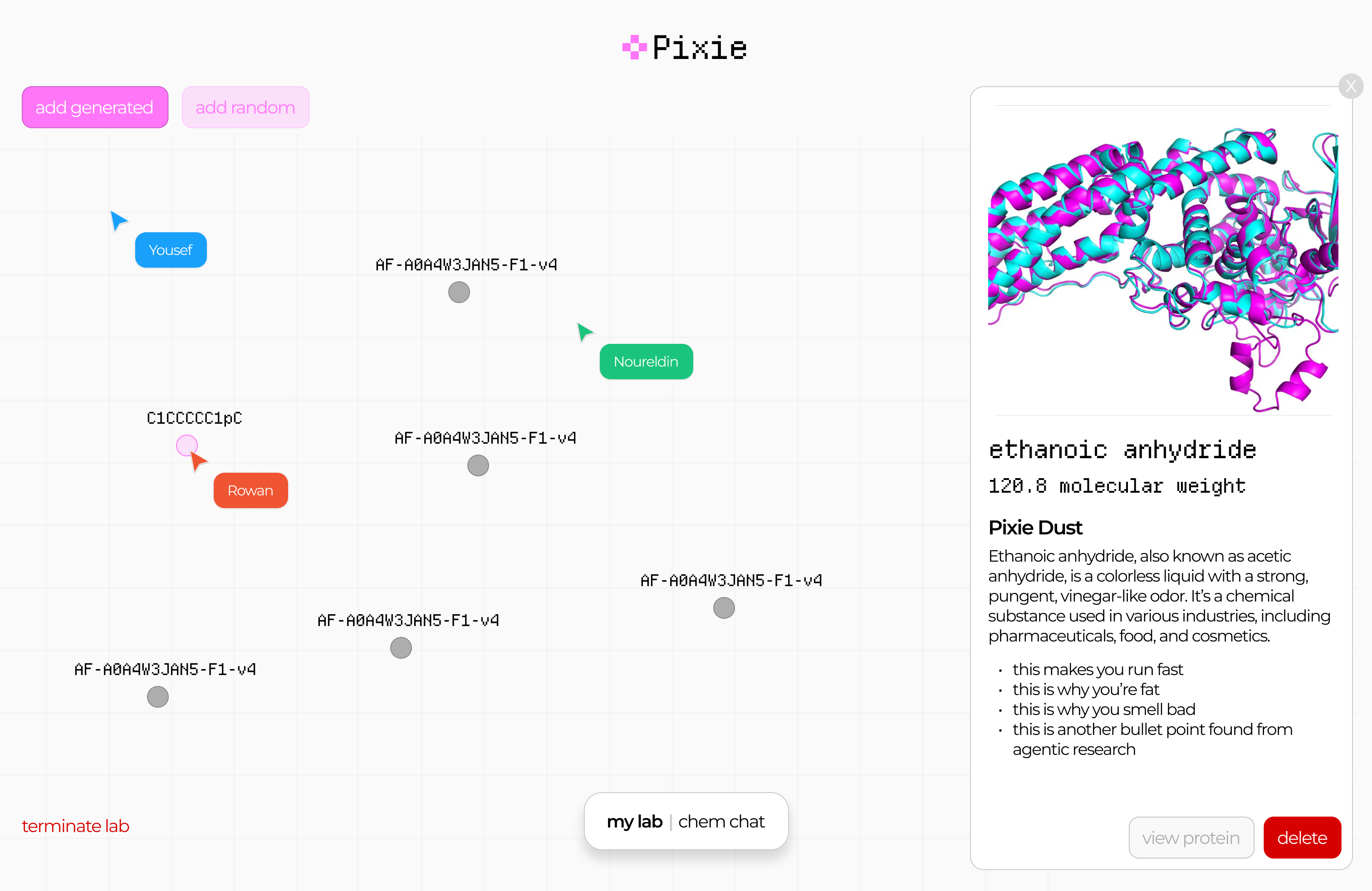
Not long after the contest was over, they killed the H100 machines and seem to have invalidated some of the API keys also, so it looks like the app is also not quite working anymore, but overall it was quite fun! We did not end up winning (unsurprisingly) but I feel like I've achieved my own goals. Rowan and Nour are very driven builders who I enjoyed working with, and CodeNode is a great venue for this sort of thing. The next week, Rowan came over to my office to co-work and also dropped off some hackathon merch. I ended up passing on the merch to other people, as I felt a bit like I might be past my hackathon years now!
Homemade lip balm
I dream of closed, self-sufficient systems. A few weeks ago, I visited the London Permaculture Festival as I'm very, very interested in permaculture. There, Hendon Soap had a stand. They were selling a DIY Lip Balm Kit.

I use lip balm regularly, so it occurred to me I ought to learn about how it's made, and maybe make my own in the long run! Today I tried my hand at making it. It's not as easy as it looks! In theory you toss everything into a sauce pan, put in 60g of oil (I used vegetable oil), and once everything is melted, you put it in the tins and put those in the freezer as fast as possible so they cool rapidly (this is to avoid a grainy texture). In theory you can also add some edible essential oils if you want a scent.
Long story short: I made a huge mess. And the stuff is quite difficult to clean. I managed to do one tin approximately right.

The rest I was mostly able to salvage and store in a little jar. When I finish that first tin, I'll re-melt that and maybe this time use a little pot with a pouring tip to avoid spilling, as well as some kind of tool for moving the very hot tins into the freezer properly! It was so hot it melted the ice in my freezer away entirely, creating a nice little indentation to hold it.

Please don't judge the ungodly amount of ice cream -- there's a heatwave coming!
The hills we live on
Just wanted to post a quick update on the ant farm. They're thriving and having all sorts of adventures!

Rising from the ashes
It's frightening how close I keep getting to killing my ficus -- they're supposed to be hardy! An update is long overdue.
First off, I moved the UV LEDs into an IKEA greenhouse. This made things much tidier and I have room for the upcoming project. The ficus had some strong growth up and to the left, all but touching the glass.
I also got these wooden drawers that you can kind of see in the back, with each one dedicated to a different project. The bottom one (taking up the whole width) is the horticulture one as that needs the most space.

Early May, I noticed that the leaves were getting brown. I thought it might be because the humidity is too high, so I thought I'd air it our a bit. Overnight it shrivelled up completely.

I was heartbroken and went to /r/Bonsai for advice. The only response I got was "it dried out and died". I did my best to try and get the humidity right and crossed my fingers. Almost two weeks later, I was delighted to see that it was still alive and had sprouted a new leaf! Can you see it?

And now, two months later, look at all this foliage!

I do plan to remove the dead leaves, but I wanted to wait for it to be a little stronger before I remove the glass again and whack things out of balance.
The hills we die on
This is a post I wrote a while ago, and recently decided may be worth publishing. It's a combination of anecdotal retelling and reflection. At the time, I had been reflecting on a paradox in my behaviour. I often go to extreme lengths to enact justice, sometimes with full knowledge that doing so is not worth it.
Most recently, I ordered something off of Etsy from Spain and I paid sales tax. The total value was less than £135, so I don't have to pay import tax. So I was surprised to find that my parcel was held at customs pending a payment of gift tax. Gift tax applies to gifts over £39, but of course this was not a gift. So HMRC wants £23.45 import VAT plus an £8 handling fee, which I had to pay to get the parcel no matter what.
The only way to dispute this sort of thing is to pay, get the parcel, then fill in a form, send that and the parcel label to Border Force (Coventry) by snail mail, wait for a human to review it, and finally they might decide that you should get a refund, or they might not. Things like this really get under my skin. Part of the reason I don't return to Germany is to escape this exact kind of ridiculous bureaucracy.
When things like this happen, I'm unable to let them go. The knowledge that there's something wrong in the world will live in my head rent-free, like an OCD urge, until I can resolve it. I need to actively prevent myself from getting too involved with other people's injustices (and I don't follow world news) or else I will feel like this all the time. However, when I have personally been wronged in some way, it's in my face and I can't let it go.
Now obviously, if you consider the Lime bike I rented to get to the post office, the cost of the padded brown envelope and postage, not to mention the time I spent researching the law and queuing in the post office, it's not worth the potential money I could recover from Border Force. But if I didn't do this, it would weigh on me probably forever. Glad to report that I got the refund at least!
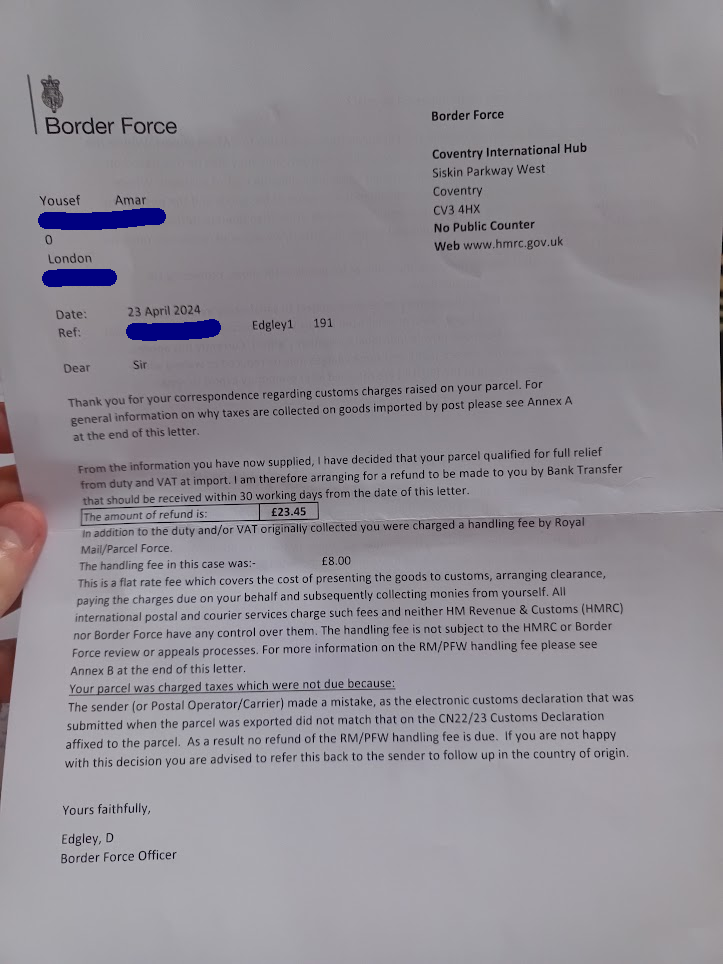
The silliest thing I've had this itch for: my local dentist owing me £5 from when their card machine was broken and I paid cash but they had no change. I had moved away and it was not worth the trip to Fulham for them to give it back to me. I was eventually able to let it go when they promised to donate it to a specific charity. Whether they did or not, I don't care, I could wash my hands of it on the back of their promise, and erase the "weight" of that injustice from my mind.
The most serious thing I've had this itch for: recovering the deposit of a flat I once lived in. Long story short, I filed an N208 claim to take my landlord to court for the maximum legal penalty of 3x the deposit amount for this particular offence. From there, things escalated very rapidly and I negotiated an out of court settlement with the director of his agency for my full deposit (and my brother's) plus court fees. Here too I was extremely annoyed at how difficult it is to do this sort of thing in the UK, and that I needed to physically go to a specific, hard-to-reach county court to file my big binder of post-it-laced documents (painstakingly printed at my nearest library) as evidence. Trees had to die and the printer at my local library had to waste ink!
I remember struggling to decide if I should even bother negotiating at that stage, or should instead drag them to court out of spite. I felt like the lengths I went to very few others would have the freedom or ability to (financial or otherwise), so I had some kind of duty to teach them a lesson so they can think twice before they decide to mess with a poor clueless student in the future. I wasted hours queuing in the rain at those free first-come-first-serve legal clinics to make sure I did things right.
Is this some kind of hero complex? Did I grow up watching too much Disney? Having held the metaphorical knife to their throat, I was able to release myself from this duty through the settlement, and erase the weight from my mind. But why did that weight persist for so long?
I have many examples like this, but perhaps the last one I'll mention for now is another David vs Goliath tale, starring me as David again, and British Gas as Goliath. What's notable about this is that it's a whole system/institution rather than specific incompetent/malicious individuals. This was another long saga that started when British Gas incorrectly classified my flat as a business, and had me on commercial rates rather than domestic rates.
There was never an individual person I could direct my rage at. British Gas is a giant lumbering machine inadvertently squishing things, the cogs in the machine unaware of its emergent behaviour. I did yell at some of the thickest of cogs -- British Gas employees and debt collector agents -- but overall, would you be angry at a transistor for a bug in your program?
The Energy Ombudsman eventually made them fix everything and also write me an apology letter. At the time this felt like vindication. I was ready to frame the letter; another notch on my belt in the struggle for justice. Who exactly did I beat though? I don't know the lady that signed the apology letter. I just looked her up on LinkedIn. She seems like a nice person. British Gas lumbers on.
There's not much of a conclusion to this post. I suppose it's a recognition of my sometimes irrational stubbornness. Sometimes I just can't let things go. My anger and frustration seems to spike around broken systems, rather than the actors that take advantage of those systems (the court rather than the landlord). I would love to build systems with few cogs that don't squish things.
Rise of the messor ants
A few days ago I turned 31. Birthdays are not something I look forward to. However, Veronica gifted me an ant farm kit, which is exciting. I have always been fascinated by ants and the emergent behaviour of ant colonies, but never had the chance to observe that IRL through glass panes. In our flat in Egypt, ants were very common, so I would sometimes intentionally leave a bit of bread out on the kitchen counter just to watch them slowly take it apart and carry crumbs in a line back into the walls from whence they came.
When I was little, I also remember seeing ant farms that use a special type of transparent gel rather than sand, so you could see everything the ants were doing. I think I saw it on ThinkGeek, a now defunct online store, and wishing I could have it.
Well, today is the day that I can say I have a proper ant farm right here in my room!

The kit was surprisingly compact.


The fledgling colony made the long trip from Spain in a little test tube. Her majesty, Queen Gina, and her children, had water soaking in through the cotton on the left, some seeds as snacks while travelling, and took care of the larvae in the back of their little temporary home.
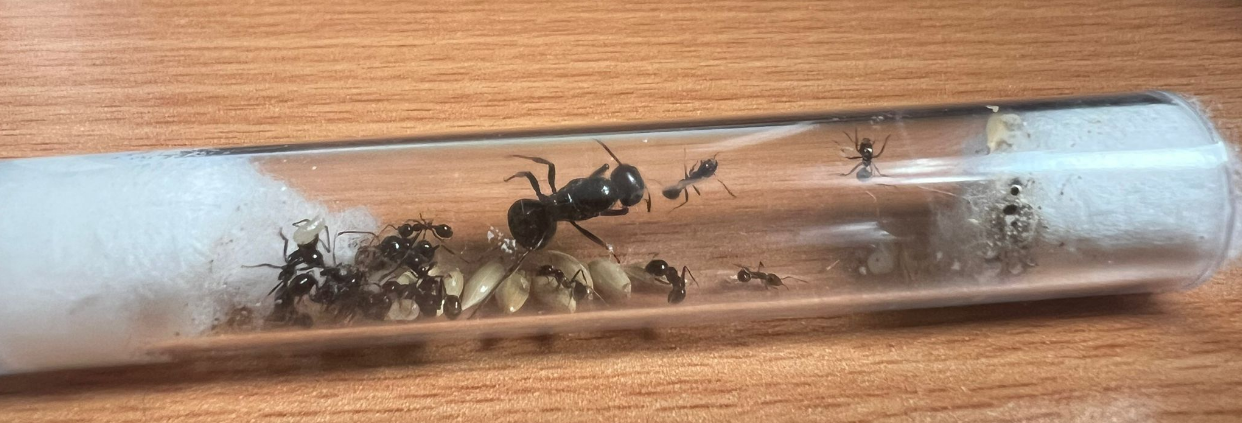
Before they could move in to their new home, I first had to make it nice and cosy for them. I started off by slowly soaking the sand over the course of the day, then decorating the top of their home. I also added their little sugar water dispenser and seed bowl. Finally, I dug a hole for them in the centre as a starting point.

I then set them free on their new home, but they stayed in the test tube for a while to build up the courage. One little brave ant ventured out, but was bringing back blue pebbles and clogging up the test tube once more. She really loved her pebbles. I later read that this is normal behaviour in order to make the queen feel more comfortable.

The moment I stopped watching they very quickly moved into their new home. I came to find the test tube empty and removed it. They had started digging and also moving the sesame seeds that Veronica had left them.


And then they started digging a LOT. I can see the beginnings of little chambers, and I read that the one at the very bottom is for storing seeds, as it's the least humid area, and they take advantage of that to prevent seeds from sprouting.


I'm excited to see how this colony develops! It's already developing much faster than I expected. I'm awaiting a new set of mixed bird seeds in the mail today, as I don't think they like sesame seeds that much, and Veronica also left them a broken up spaghetti.
Ficus rollercoaster
I recently wrote about my ficus terrarium and how some kind of mould defeated my fittonia. Since then, I've learned a lot more about terrariums (including learning about ones where you keep frogs and reptiles, from a very friendly pet shop employee). The ficus however, which is meant to be quite hardy, did eventually have the same mould problem.
By early January, it was getting quite dire. No matter how much I tried to control the humidity, the leaves were all dying and there was thread-like mould forming like spider webs. I don't think I took a photo of this.
I did some more research and found a potential solution: little creatures called springtails (this was later confirmed to me by friendly pet shop guy). I ordered live Springtails off of Amazon (I didn't know you could do that) and they arrived quite quickly.

They arrive in some soil. The cardboard box they arrived in was smaller than the plastic container, so the act of squishing the plastic container into that box had caused it to open. It was kind of a messy situation. Regardless, I introduced them into the terrarium, slowly adding more over time. They're kind of hard to see with the naked eye, but if you really focus you can see them crawling around. They can also jump, which to me looks like they just disappear.
Fast-forward to today... it worked! They cleaned up the mould on the glass as well as the white threads that were attacking the plant. They seem to fit well into this ecosystem! I still have the container with the rest of them, which I might have a future use for (hint: my ant farm I will write about soon).
I am glad to report that new leaves have sprouted, and the health of the ficus looks like it's slowly improving!

Stay tuned to know more about my horticulture adventures, including a new plant project that I will write about soon! Hint:

Blast from the past: "Cult II: Federal Crime"
Do you remember when you could get CD-ROMs with a ton of old games on them? A few months ago, I remembered playing one such game that was on one of those CDs. I can't 100% remember where I got it, but I was maybe around 10 years old, and my family was struggling financially. A family friend, Aunt Wafaa (who has since unfortunately passed of breast cancer), took me to a MediaMarkt (consumer electronics store) and said I can pick out any game for my birthday. I probably thought I could get 50 or 100 or however many were in that "collection" CD for the price of one.
What stuck with me about this particular game I remembered was the soundtrack. They were all MIDI tracks, and I could remember every note. For the life of me, I couldn't remember the name of this game, but I found a subreddit called /r/tipofmyjoystick where you can post about games you don't remember the name of, and very often the community manages to find it. Indeed, when I made a post titled [PC][00s]Top-down rpg/puzzle game, Reddit user Vellidragon cracked it in no time! Here is my post (warning: spoilers marked in the description):

I asked him how he knew, and he said:
I had the first Cult on a shareware CD way back, wondered if that could be it but found videos of the sequel when searching and realised it must be that.
I was delighted to have found it again and after some digging, found that the original website was still up, and you could still download the game for free from there. I also read that there might be an Android port now, but I couldn't quite find it. I was also surprised to find that the website contained a stitched-together map of the game (warning: contains spoilers), a view I had never seen before.
I decided to play through the game once more. I did so in three or four sessions together with Veronica. I only remembered bits and pieces about the plot so it was as if I had never played it before. Truly a blast from the past.
I also remembered the frustrating bits that time had softened my memory of. This was a typical adventure RPG of the time, where you talk to NPCs who you do small tasks for that may give you items that you then use for other tasks etc. One annoying mechanic however was the way that the progression was controlled using doors and switches. Sometimes doors are opened by NPCs and it's obvious where you need to go, but other times a switch you press opens a door on the other side of the map, with no logical connection, so you spend a lot of time running around the map checking if any new doors have opened. It's easy to get stuck and either have to scroll through the walkthroughs, or try to use every item in your inventory on every character in the off chance that it does something.
Anyway, after replaying the game, I took another look at that map. I couldn't quite put the feeling to words. It's like visiting a familiar place that you've moved on from, but with completely new eyes. It somehow contains this whole world that I spent hours in, in a single picture. It also makes me want to build my own worlds in this way, where the individual components are so simple, but the emergent complexity and richness of the stories within stick with you for decades.
Thoughts on chat as an interface
Chat as an interface has always been something I thought about a lot. After all, it's a close analogue to spoken conversation, our most natural form of communication.
The most basic chat interface is an input box and a chronological history of messages, so you can follow the conversation. Messages are often augmented with emojis etc to fill in the gaps for intonation and body language. If you need higher communication bandwidth, voice messages do it sometimes too. Advantages over face-to-face conversation is that text-based conversations have the option of being asynchronous and much longer-lived, potentially even pen-pal style correspondences.
Group conversations
The moment you start thinking about group conversations, some problems begin to be unearthed. One problem is it can get quite crowded, as you're sharing a linear chat history. It's hard to follow multiple threads of conversation that have been flattened into one, when in real life conversations can branch off and diverge.
This is a problem in video conferences too. While at a social event, groups naturally divide into smaller clusters of people in their own bubble of conversation, this has to be done explicitly in video conferences through breakout rooms and similar mechanics. Otherwise all the attention and spotlight is aimed at the person currently talking, which can throw off the dynamics.
I first noticed this phenomenon when I was running the Duolingo German language events in London. It's already common for people who don't know the language well to be shy about speaking up, but when covid started and we switched to Zoom, it was very easy for whomever is speaking to get stage fright, even if they're not normally shy. What then ends up happening is that two or three people will engage in conversation while the rest watch, unless the host (me in that case) takes control of the group dynamics. This was much easier to do in-person, especially where I could see the person's face and gauge how comfortable they are, so I don't put them on the spot (e.g. by bringing them into the conversation with simple yes/no questions).
Attempts at solutions
Anyway, during covid I became quite interested in products that try to solve these problems by capturing aspects of real-life communication through product design. I remember imagining a 2D virtual environment with spatial audio in the context of my PhD research. It turned out somebody was already building something similar: a fellow named Almas, and I remember having a call with him about SpatialChat (a conversation full of lovely StarCraft metaphors). This was an environment that allowed you to replicate the act of physically leaving a huddle and moving to a different cluster to talk. You could only be heard by those in "earshot".
A 2D game called Manyland did something similar with text-only, where text would appear above the head of your character as you were typing. This created interesting new dynamics and etiquette around "interrupting" each other, as well as things like awkward silences, which don't exist when you're waiting for someone to type. There was even an odd fashion around typing speed at one point.
Interestingly, you're not occupying space in the chat log by chatting; you're filling the space above your head, so you just need to find a good place to perch. Two people can respond to the same thing at the same time. However, one person can't quite multi-task their responses / threads without jumping back and forth between people, but after all that's how it works in real life too, no?
Reply chains and threads
I won't go over the history of different chat platforms and apps, but we've seen a lot of patterns that try and create some structure around communication, here in order from more ephemeral to less ephemeral:
- Quoting a message to reply to inline
- Ad-hoc threads that create a separated chat log
- More permanent threads akin to forums
- Permanent "topic" channels
I like to imagine conversations as trees, where branches can sprout and end just as fast. Have you ever been in an argument where someone rattles off a bunch of bad points, but you can only counter them in series? Each of your responses may in turn trigger several additional responses, and you get this exponentially growing tree and eventually you're writing essays dismantling every point one by one.
In real life, it's often hard to remember everything that was said, so you focus on just the most important parts. Or you deliberately prune the branches to the conversation doesn't become unwieldy. Some people like to muddy the waters and go off topic and it's up to you to steer the conversation back to the main trunk.
But not everything is a debate. A friend of mine figured that this tree, in 2D, ought to be the way to hold conversations. Big big internet conversations (he used social media as an example) are all adding nodes to far off branches of a huge tree. I quite like that picture. It would certainly allow for conversations to happen in parallel at the same time as you can hop back and forth between branches.
ChatGPT and the history tree
ChatGPT made the choice that chats should be linear, but you can start a new chat with a new instance of the AI at any time, and go back to old chats through the history tab. This seems to make sense for chatting with an AI assistant, but an anti-pattern emerges...
Have you ever gone down a conversation with ChatGPT only to realise that it's dug itself into a hole, so you scroll up to just after the last "good" message and edit the message to create a new, better timeline? I do this a lot, and it reminded me of undo/redo in text editors.
Undo and redo are normally linear, and if you go back in time and make a change, suddenly the old "future" is no longer accessible to you. We've all done it where we accidentally typed something after pressing undo a bunch of times to check a past version, losing our work.
Someone made a plugin for vim that allows you to navigate a tree of timelines that you create by undo-ing, sort of like automatic git branching and checkout. I feel like this ought to be a UI for interacting with ChatGPT too! Already this is being used for better responses and I feel like there must have been attempts at creating a UI like this, but I haven't seen one that does this elegantly.
Conclusion
This has been kind of a stream of though post, inspired by my post on resetting my AI assistant's chat memory, so I'm not entirely sure what the point I'm trying to make is. I think I'm mainly trying to narrow down the ergonomics of an ideal chat interface or chat in a virtual environment.
I think you would probably have some set of "seed" nodes -- the stem cells to your threads -- which are defined by individuals (i.e. DMs), or groups with a commonality, or topics. These would somehow all capture the nuances of real-life communication, but improve on that with the ability to optionally create ephemeral threads out of reply branches. I'm not yet sure what the UI would physically look like though.
Ficus in a glass egg
I was recently offered condolences when someone found out about the unfortunate fate that befell my Bonsai plant. There's a small update!
A little over a month ago, Veronica and I went to a terrarium workshop and put together a little home for a little ficus. They're very hardy.

I picked everything out down to the colours of the sand layers and we carefully placed and aligned everything. It's not just pretty, but everything has a function. For example, the moss tells you when when it's time to add (distilled!) water, the large rocks can provide a surface for that water to evaporate (rather than get absorbed by the moss). We also added two dinosaurs, one patting the head of the other one.
As hardy as the ficus is, unfortunately the fittonia in the back was a lot more temperamental. I thought it maybe couldn't handle the humidity (the guides said you shouldn't let too much condensation build up on the glass) or it needed more light. It unfortunately started getting these strands of mould and eventually became a gloop.

I called the workshop instructor and he said there may be a number of reasons for this, asked for photos to troubleshoot, and he offered to replace it if I came by, but Shoreditch is kind of a trek from here. He said I should take it out so that it doesn't damage the ficus. In the meantime, I also got some grow lights so I can have a bit more control over the environment, rather than be at the mercy of UK winter weather!

Why no Indieweb Carnival posts?
I've been participating in the Indieweb Carnival for a while. Usually I'll take the themes on by freewriting. These past two months, for the themes Self-Care and Routine and Community and belonging, I wrote approx 2000 words each, but I never published these.
The themes are often deep and elicit introspection and vulnerability, especially these past two. I tend to knock them out on long train rides or flights where I'm offline (most recently for the ones for Oct, Nov, Dec: Birmingham, Manchester, Cairo, Ismailia, Riyadh). While tackling these themes is a useful exercise for me, I realised that sharing the output with the public is not.
Prior to the past two themes, I published my Indieweb Carnival writing, but I had them unlisted on my website. You can only read them via webmention links or if they're linked to by Indieweb Carnival organisers. The reason for this is that it's not unusual that I write about something personal, and the target reader in my mind is a complete stranger. I'm oddly ok with sharing certain things with strangers, but the issue is that not only strangers visit my website.
Sometimes I will reread what I wrote, but imagine a different persona reading. I'm comfortable sharing different things with different people, e.g. family, friends, colleagues, clients, etc. These categories are not "nested" in the sense that my inner circle ought to have access to everything, with permissions tightening as you move out the circles. Instead, these are usually non-overlapping and dependent on the content itself.
When I re-read something from the perspective of a different group, or even individual, inevitably I will want to modify what I wrote. The more I share, the harder it is to juggle these personas in my mind and release something that I'm happy sharing with the widest group of all: everyone.
For the past two topics, I found that I went deep enough that I could no longer imagine what future inference could be made from that personal information, who may read this one day after I've forgotten about it or have changed my mind on what I wrote, and how the current people in my life may view these things.
In short: the less I think about what I write, the more I overthink who reads, and vice versa. That's no good if you want to freewrite. So I decided to stop publishing these posts. Or rather, restricting them to an audience of one: me[1].
I suppose my website might be a little less colourful as a result, but maybe one day I can figure out some kind of access control system, or create a new identity separate from my main one.
This is not the most restrictive audience, since I assume that anything I write may possibly one day be read by others (e.g. though a data breach), and I also draw a distinction between different versions of myself across time, and AI (think Roko's Basilisk), but that's a topic for another time. ↩︎
Disaster has struck
Towards the end of August, I went to visit my mum in Germany. Veronica would take care of my bonsai plant in my absence. One day she woke up to a gruesome murder scene (warning, graphic images to follow).

Veronica thought it got too top-heavy and broke, but Black Pine saplings don't just explode like that. I knew it was our cat Jinn. In a bunch of further images, I noticed what look like nibble marks too. I know she likes to nibble on grass too. I insisted that she immediately tell the cat off and show her what she did wrong. Cats are not that smart and won't be able to connect consequences to their actions unless they're tightly associated. In my opinion, Veronica is consistently too soft on the cat.
Veronica felt bad about the death of bonsai buddy (although she insists it can still be saved) but it seemed to me a 10 year journey was cut prematurely short. There's not much that can be done in my opinion except starting over. Since I've been back, I've been seeing if it can be saved, with not much success yet. This is what it looks like today:

When I came back, Jinn was very misbehaved for a bit. She knows she's not allowed to jump on my desk -- twice I caught her doing so and sniffing the bonsai corpse while she thought I was asleep. She knows that certain other areas are out of bounds for her, and she was pushing those boundaries. It took her a week or two of me being back for her to go back to normal and for us to be friends again.
R.I.P. bonsai buddy
Thoughts on interfaces, AI agents, and magic
In UI design, Skeuomorphism is where UI elements look like their physical counterparts. For example, a button might have highlights/shadows, you might adjust time through slot-machine-like dials, or hear a shutter sound when you take a photo. I quite like skeuomorphic design.
I pay special attention to icons. My younger sister is young enough to have never used a floppy disk and therefore only knows this symbol 💾 to mean "save" but not why. You see it everywhere: icons (like a phone handset), language (like an "inbox"), and other tools (like the dodge and burn tools in photo editors, which stem from physical retouching on film).
Sometimes, words have gone through several layers of this, where they're borrowed over and over again. For me, one area where I see this a lot is in networks. In the days of radio and analogue electronics, we got a lot of new words that were borrowed from other things that people were already familiar with. Once computer networks came along, suddenly "bandwidth" adopted a different meaning.
The key here is this idea of familiarity. When something is new, it needs to be rooted in something old, in order for people to be able to embrace it, let alone understand it. Once they do, only then do you see design trends cut the fat (for example, the shiny Web 2.0 style made way for the more flat design we have today). If a time traveller from 20 years ago were to visit, of course they would find modern design and affordances confusing.
Take this a step further however: what about the things that never had a physical counterpart or couldn't quite be connected to one? Well, it seems we latch on to the closest available concept or symbol! For example, what exactly is "the cloud"? It never substituted water vapour in the sky; it was something new. Why is this ☰ the symbol for a hamburger menu? Because it sort of looks like items in a menu. Not to mention, why did we call it a hamburger menu? Because the symbol sort of looks like a hamburger.[1]
Anyway, why do I bring all this up? Because I noticed new words and icons showing up in the AI space, as AI is becoming more ubiquitous. AI assistance built into tools are becoming "copilots". The symbol for "apply AI" is becoming magic sparkles that look a bit like this ✨. I find this very interesting -- people seem to not quite have a previous concept to connect AI to other than "magic", and the robot emoji might be a little too intimidating 🤖 (maybe I should change the Amarbot triggering reaction to sparkles instead).
A couple days ago, this was trending on HackerNews, and sparked some conversation in my circles. As you might know, I have some interest in this space. It seemed to have some overlap with gather.town, a 2D virtual environment for work. This category really took off during covid. This product in particular has some big name backers (though not a16z ironically enough).
This got me thinking... AI agents would truly be first-class citizens in environments like these. You would interact with them the same way you interact with a human colleague. You could tell them "go tell Bob to have the reports ready by 2pm" and the agent would walk over to Bob's virtual desk, and tell them using the same chat / voice interface that a human would use.
How would agents interact with the outside world? LLMs already have an understanding of human concepts baked in. Why hack a language model to execute code (Code Interpreter) when you could use the same skeuomorphism that humans are good at, in an environment like this? If there's a big red button in the corner of your virtual office called "server restart button", a human as well as an AI agent can easily interact with that. Neither may ever know that this magic button does something in a parallel universe.
It might be some ways off before we're all working out of the metaverse, but I believe that the only way for that to happen is if it becomes more ergonomic than real life. It just so happens that this is great for humans as well as AI agents! There are already a class of tools that make you more productive in AR/VR than on a normal monitor (think 3D CAD). However when it comes to day-to-day working, organising your thoughts, communicating, etc, we still have some ways to go. To cross that bridge, we most likely need to embrace skeuomorphic design in the first instance.
What might that look like? Certainly storing information in space. Your desk top (and I don't mean "desktop", I mean literally the surface of your desk) can go 3D, and you can perhaps visualise directory trees in ways you couldn't before. Humans have excellent spatial reasoning (and memory) as my friend working on virtual mind palaces will tell you.
You could of course have physical objects map 1:1 to their virtual counterparts, e.g. you could see a server rack that represents your actual servers. However, instead of red and green dots on a dashboard, maybe the server can catch on literal fire if it's unhealthy? That's one way to receive information and monitor systems! A human as well as an AI agent can understand that fire is bad. Similarly, interactions with things can be physical, e.g. maybe you toss a book into a virtual basket, which orders a physical version of it. Maybe uploading a photo to the cloud is an actual photo flying up to a cloud?
Or maybe this virtual world becomes another layer for AI (think Black Mirror "White Christmas" episode), where humans only chat with a single representative that supervises all these virtual objects/agents, and talks in the human's ear? Humans dodge the metaverse apocalypse and can live in the real world like Humane wants?
Humans are social creatures and great at interacting with other humans. Sure, they can learn to drive a car, and no longer have to think about the individual actions, rather the intent, but nothing is more natural than conversation. LLMs are great at conversation too of course (it's in the name) and validates a belief that I've had for a long time that conversation may be the most widely applicable and ergonomic interaction interface.
What if my server was a person in my virtual workspace? A member of my team like any other? What if it cried if server health was bad? What if it explained to me what's wrong instead of me trawling through logs on the command line? I'm not sure what to call this. Is this reverse-skeuomorphism? Skeuomorphic datavis?
I might have a fleet of AI coworkers, each specialised in some way, or representing something. Already Sentinel is a personification of my smart home systems. Is this the beginning of an exocortex? Is there a day where I can simply utter my desires and an army of agents communicate with each other and interact with the world to make these a reality?
(Most) humans are great at reading faces (human faces that is, the same way Zebras can tell each other apart). This concept was explored in data visualisation before, via Chernoff faces. There are reasons why it didn't catch on but I find it very interesting. I was first introduced to this concept by the sci-fi novel Blindsight. In it, a vampire visualises statistical data through an array of tortured faces, as their brains in this story are excellent at seeing the nuance in that. You can read the whole novel for free online like other Peter Watts novels, but I'll leave the quote here for good measure:
A sea of tortured faces, rotating in slow orbits around my vampire commander.
"My God, what is this?"
"Statistics." Sarasti seemed focused on a flayed Asian child. "Rorschach's growth allometry over a two-week period."
"They're faces…"
He nodded, turning his attention to a woman with no eyes. "Skull diameter scales to total mass. Mandible length scales to EM transparency at one Angstrom. One hundred thirteen facial dimensions, each presenting a different variable. Principle-component combinations present as multifeature aspect ratios." He turned to face me, his naked gleaming eyes just slightly sidecast. "You'd be surprised how much gray matter is dedicated to the analysis of facial imagery. Shame to waste it on anything as—counterintuitive as residual plots or contingency tables."
I felt my jaw clenching. "And the expressions? What do they represent?"
"Software customizes output for user."
There are so many parallels between language and programming. For example, Toki Pona (a spoken language with a vocabulary of only 120 words) is like the RISC of linguistics. You need to compose more words together to convey the the same meaning, but it's quite elegant how you can still do that with so few words. It seems like languages don't need that large a vocabulary to be "Turing complete" and able to express any idea. Or maybe because language and thought are so tightly coupled, we're just not able to even conceive of ideas that we don't have the linguistic tools to express in the first place.
You can create subroutines, functions, macros in a program. You can reuse the same code at a higher level of abstraction. Similarly, we can invent new words and symbols that carry a lot more meaning, at the cost of making our language more terse. A language like Toki Pona is verbose because ideas are expressed from elementary building blocks and are context-dependent.
I imagine a day where abstractions layered on top of abstractions disconnect us from the underlying magic. You see a symbol like the Bluetooth icon and it has no other meaning to you except Bluetooth. In your virtual world, you interact with curious artefacts that have no bearing on your reality. You read arcane symbols as if they were ancient runes. You cast spells by speaking commands to underlings and ambient listeners that understand what you mean. Somewhere along the way, we can no longer explain how this has become a reality; how the effects we see actually connect to the ones and zeros firing. Is that not magic? ✨
This is sometimes called a drawer menu too, but the point still stands, as it slides out like a drawer. Other forms of navigation have physical counterparts too, like "tabs" come from physical folders. One you start noticing these you can't stop! ↩︎
Two new puzzles
I was sent two small puzzles by two separate friends recently. The first was from a friend who is currently visiting Gothenburg, Sweden, and spotted one of the programming recruitment puzzles. I might have seen this exact one through an ARG community, but couldn't quite remember.

We were chatting on the phone at the time, so I tried solving it in my head talking through it out loud, and got the right URL first try! If you can't be bothered to solve it, the URL takes you here, and as expected, it's a recruitment funnel.
Then, a more traditional puzzle:
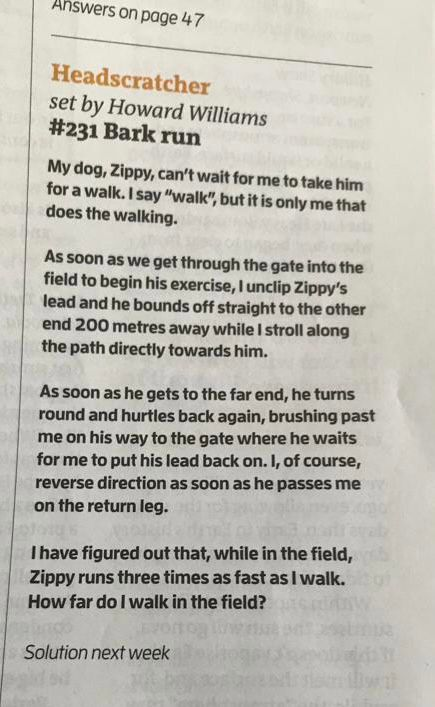
After scratching my head for a bit, my solution was as follows (spoilers!):
- Simplify the situation by instead assuming Zippy starts 400m away from the gate, and you start at the gate, and you're running towards each other (it's the same)
- Zippy runs at 3x your speed, so by the time you meet, he will have covered 3x the distance as you
- Chop the 400m into quarters, give Zippy 3 and yourself 1
- 400/4 = 100m, so you meet when you're halfway into the park!
Impossible password requirements
Recently, there was this password game trending (and was also on the front page of HN). It goes quite deep, and I really like the variety of the challenges. I ragequit after my chicken died of overfeeding (you'll know what I mean when you reach it), especially because the game is different every time you play it, so you can't just copy-paste, but have to restart from scratch.
Anyway, coincidentally, as I was sorting through some old bookmarks, I came across this link: https://www.troyhunt.com/partnerships/. I was really confused as to why I bookmarked this. The automatic summariser summary was very innocuous.
troyhunt.com seeks partnerships for cross-platform solutions and value-added web services. To start the process, an account must be created.
Troy Hunt is the guy who made "Have I Been Pwned". My confusion ended once I actually tried to make an account. I remembered that he made this page to send scammers to and have them waste time trying to satiate impossible password requirements!
I mentioned many times that I like these sort of puzzles (and I still need to write about my own various attempts at similar ones), but some of these password ones are really quite clever and a great inspiration!
Bonsai diversification
My Red Maple and Wisteria seeds haven't sprouted yet, but I was left with all this extra soil! So I decided that I ought to plant the other species too. The remaining seeds I have are for Black Pine, Cherry Blossom, and Japanese Cedar. This is what they look like respectively:

I only had three Cherry Blossom seeds, and unlike the Red Maple, I decided to only plant one seed in that pot. Besides that, I've largely only used half of the seeds I have of each species so far, and I'm thinking that even that is unnecessary, but let's see!
As I was soaking them for 48 hours, they kind of got mixed up a bit, and I had a bit of a challenge separating the Black Pine from the Cherry Blossom, but I think I got there in the end. To better keep track of everything, as I was really starting to forget which is which, I put in some little wooden sticks:

The soil had dried quite a bit, so I made it wetter, maybe even a little too wet, as it was soaking the cotton on the bottom and created some condensation on the plastic. I also used tap water, which I didn't do for the first two, as it's pretty hard / rich in calcium. For my tomato plant, the effects of this were soon obvious as calcium residue was visible on the top of the soil and edges of the soil where it meets the pot. I didn't want to have the same for these plants, but it should hopefully all be OK.
If you'd like to learn some more about each species, here are their sections in my little book:


So now we have 5 different pots stratifying -- let's see which sprout first!
Bonsai sowing and stratification
My bonsai seeds have soaked for 48 hours and I'm ready to move on to the next step! The reveal: I picked Wisteria and Red Maple. They ticked all the right boxes for me as my first try.

The Wisteria seeds are the small ones and the Red Maple are the two big ones. I used half of the seeds that I had of each species.

I assembled the "Auto Irrigation Growing Pot" and tried to ignore the conflicting instructions. I think you're not meant to fill the reservoir with any water at all until after the Stratification step (which I'll explain in a sec), and it's ambiguous how deep the seeds should go beyond "same depth as the size" (the size of what, the seeds?), so I just used my best judgement.
It turns out that I actually have a lot of soil. I didn't even use up a full peat disc so far. I have three more pots, so I'm considering getting some more seedlings started in the meantime and increase the chances of success...
At any rate, I sowed the current seeds and sprinkled a tiny bit of water into the soil to keep it moist, as it had dried out a bit in the meantime. I don't think the instructions should have the soil bit as step 1 if you're then going to soak the seeds for 48 hours after that, it should really be the second step.

And now that they're sown, I put them in the fridge. In the fridge, the one on the left is the Red Maple (this is more of a note to myself -- I should label them really; there are little wooden sticks for that in the kit). Putting them in the fridge is the first part of the Stratification step, which is meant to simulate winter conditions, then spring, so that they can germinate as they would in nature.
I'll be checking on them every few days and keeping the soil damp. Hopefully in two or three weeks they will start sprouting and I can remove them from the fridge. I set some calendar events. So now we wait!
Banzai, bonsai!
I finally decided to start on my bonsai project. To read more about what this is all about, check out the project page. I haven't written anything about the tomato project, or any of the other (failed) horticulture projects, but I will eventually, since documenting failures is important too! This is the first log of what is probably going to be rather perennial chronicles.
The kit that I'm using to get a start with bonsai is really quite neat. It comes with 5 different species of seeds: Japanese Wisteria, Cherry Blossom, Japanese Cedar, Red Maple Tree, and Black Pine Tree.



This is a great set of tools in such a small package and I'm quite excited! The instruction booklet goes into a decent amount of detail, though I already know a bunch from YouTube and other places as I had a general interest in bonsai before deciding to try myself.
It came with two peat pucks that you put in some water and watch as they slowly grow while they absorb the water.

I decided to do both of them, as I wanted to try multiple species at the same time, and they grow to about 3x their original size! It's actually quite a lot of soil.

I then decided on two species that I wanted to grow. The next step was to put some of the seeds in warm water for 48 hours, such that they can soften, which makes it easier for the seedling to break through the shell. The two that I picked had seeds that looked very distinct from each other!
If you would like to know what species I picked, check back in 48 hours when I document the sowing process! I'll give you a hint: I didn't pick the mainstream choice (Black Pine).
Forums and data-hoarding
A few days ago, I wrote a post where I reminisced about the online forums of yesteryear. I mention tracking down and reaching out to a webmaster of a forum that meant a lot to me. Well, I have an update: she responded, and it was indeed her! I considered asking her if she might be open to digging up any backups she might have had, but then I thought about it, and I figured that perhaps some things are better left in the past. I don't remember the contents of those posts, but I do remember the positive emotions, and I think that's enough.
This leads me onto a topic that I've wanted to write about for a while: data-hoarding. I personally struggle with the concept of entropy in general. This manifests itself in many ways, but a clear one is information loss. If I were to leave this unchecked, I could see myself easily becoming a data-hoarder. The impulse is much stronger for unique data that I created (personal data), and in fact this is probably a strong motivator for my note-taking, as I see writing as a form of "backing up my brain". I've barely scratched the surface, but I reckon with enough data, I could even be resurrectable.
In my personal notes, I have a directory called "maxims", where I reason about a set of principles that I live my life by. There are however a certain set of mental tools that help me cope with life in general, but aren't quite at the level of certainty of a "maxim". I decided to start writing these down, and for now I'm putting them in a separate folder called "meditations" (kind of inspired by Marcus Aurelius' writing) until I come up with a better name.
The reason I bring this up is because there's a useful tool that helps me mitigate this urge to hoard personal data, namely picturing the notion that, for all we know, physics seems to indicate that our universe is time-reversible (except when you're dealing with black holes, but let's not get into that). In other words, if you know the end state of a system, and its evolution laws, you can simulate it backwards and determine a previous state, regardless of how chaotic it may be. Of course, it's one thing to calculate where a thrown ball originated from, another to un-burn a book, but physically it's all the same.
Similarly, relativity seems to indicate that if you travel at the speed of light, then all of time can exist at once, bringing up the concept of a Block Universe, and our perception of past and present is more of a side-effect of our mode of existence. To that end, I like to imagine that if certain data has existed at some point, then it is "stored", and theoretically retrievable, in the past, or the Akashic Records to use the term I learned from Ra. If not through "time-travel", then if someone were to take a perfect snapshot of our universe and simulate physics in reverse.
If you find this kind of thing interesting, I recommend Sabine Hossenfelder's book "Existential Physics", which she signed for me after a talk at the Royal Institute!
Before I get too carried away, let me write down one more story. When I was little, we had a Win 98 computer. I knew that machine inside and out. I remember all the games I used to play on it with my brothers (anyone remember the Worms games?) and I remember making little games with the old versions of PowerPoint. We made a mouse-maze game at one point, called "The A-maze-ing Maze", and in my head I can still hear the voice-over recording that I asked my brother to make for the instruction slide of the game, and his inflection of the word "maze".
I kept it in good working condition probably until I went off to university. Some people are amazed at how well-kept my projects from the early 2000s are, but that computer truly had even the earliest projects I ever worked on on it.
My mother didn't like that I always had electronics and hardware lying around in my room. She often threatened to throw my things out. I told her that this old computer was especially important to me, and I put it in my closet so that it's not in the way.
At some point, I probably came back home from uni to visit, and the computer was gone. My mother told me that she had it scrapped, and it was long gone at that point. I can't remember how I reacted, but I often remember the feeling, and I'm not sure if I'll ever get over that loss, as silly as that may sound. It truly felt like losing a part of myself.
I have a good relationship with my mother, and I've brought this up several times since then, but I don't think she quite understands what it meant to me, and she never apologised. Usually, she says that she assumed that I had already pulled out the hard drive, as I had a very tall stack of what she assumed were hard drives (they were actually CD-ROM drives).
Anyway, I'm not writing this to roast my mum! In fact, allow me to add one more anecdote (I lied, sorry) to offset the above story somewhat. One of my earliest memories of losing progress that hadn't saved was when playing the game "Amazon Trail" (a somewhat more modern spin-off of the well-known Oregon Trail). I made hours of progress on that game, and lost everything to a crash. My mother was the one who was there to comfort me as I cried.
I'm sharing this to put into words a different kind of loss, and a means of managing it. Like with the death of a person, you can imagine that they exist on in your memories. I like to think that the things I lose exist in a much more concrete way, in space-time itself, and that the loss was deterministically inevitable.
While that might not yet enable me to let go of certain losses, I can at least avoid obsessing over hoarding other data, and allowing certain things to be forgotten. Perhaps that can help someone else too!
Urban planner puzzle
Veronica recently sent me this puzzle:

In English: the grid is a city and you must place buildings in the cells. Buildings can have a height between 1 and 5 floors inclusive. Rows and columns have Sudoku rules; you can't have a building of the same height be on the same row/column. The numbers on the edges are how many buildings are visible from that vantage point.
So for example, for a row of 13254, the number on the right would be 2 (you can only see the buildings 4 and 5) and the number on the left would be 3 (you can only see 1, 3, and 5).
Give it a go then check against my solution!
My solution
| 2 | 4 | 1 | 3 | 5 |
| 3 | 5 | 2 | 4 | 1 |
| 5 | 2 | 4 | 1 | 3 |
| 4 | 1 | 3 | 5 | 2 |
| 1 | 3 | 5 | 2 | 4 |
DreamViews birthday wishes
When I was much younger, after the internet had already picked up mainstream steam, but before social media, I spent a lot of time on online forums. The communities were small (and even if they were big, the "regulars" were a small community) and everyone knew everyone. Most of these no longer exist and the chances that I can reconnect with the friends I made are very slim, which is a shame as they've strongly influenced who I am today. I hear that similar communities exist on Mastadon and in some pockets of the internet but I already know it just won't be the same.
I'd get home from school, sit at the family computer, and check for new posts in threads I was part of. For the smaller ones, I would check all new posts on the entire forum and I engaged in a lot of discussions. I remember runescape-tip.com with waves of nostalgia as I just looked it up on the Wayback Machine (we're talking mid-2000s). I also remember the mutual support between friends on teenforum.tv, under the administration of the 21 year old webmaster and MySpace-layout-maker Nora, who seemed so old and wise at the time. Some friendships survived the forums' demise, but somewhere between transitions from MSN to Skype and beyond, it all fizzled away.
One forum that survived to this day however is dreamviews.com, although it looks quite different to how I remembered it. In typical vBulletin fashion, every year I get a birthday email from there, and every year I remember the friends I made on there. We obviously spoke a lot about lucid dreaming, a topic I was very interested in (though barely had any), but also a lot of off-topic stuff. Judging by the length of time the emails go back, I was active on there "only" as far back as 2010, which is later than the others.
I remember checking DreamViews one day, a long time ago, after I had already been inactive for quite some time (probably as I was at uni and busy with life) and I saw a post with one of the more veteran users on the site, reminiscing about all the "old" active users that had gone inactive. He listed usernames that I recognised, and mine was among them! That was the first time I considered that I too might have had an impact on all these people who had an impact on me, and that I wasn't just a random internet stranger to them. By the time I saw that post, the veteran user had also already moved on, so I decided to leave it there, and preserve these memories in my journaling as best I could.
I once tracked Nora down on a different platform, in 2014 (6 years after teenforum.tv died) and she had responded, according to my email notifications. I don't know what that response was anymore, because even that different platform (some kind of design community) is now dead too. Today, I did some sleuthing, and tracked her down on LinkedIn. I messaged her 5 minutes ago, and who knows, maybe she still has a backup of those forums and I can reminisce over the conversations? If anything comes of it, I'll be sure to post!
Statue inpainting
I can't imagine I'm the first to try this, but new hobby acquired:
- Go to the British Museum (other museums with statues will work too!)
- Find broken statues
- Take a photo
- Erase the gaps (DALL-E 2 lets you upload and edit on the fly)
- Write the name of the piece as the prompt, with the date
- Use image inpainting to fill in the rest of the statue
I ran the ones below on the spot and it was quite fun. Before this, whenever I visited the British Museum (a few times a year), I didn't really give most of those statues a second glance.


An exercise for the reader (this one's interesting because they put a reference of what it could have look like if it were complete based on a different statue):
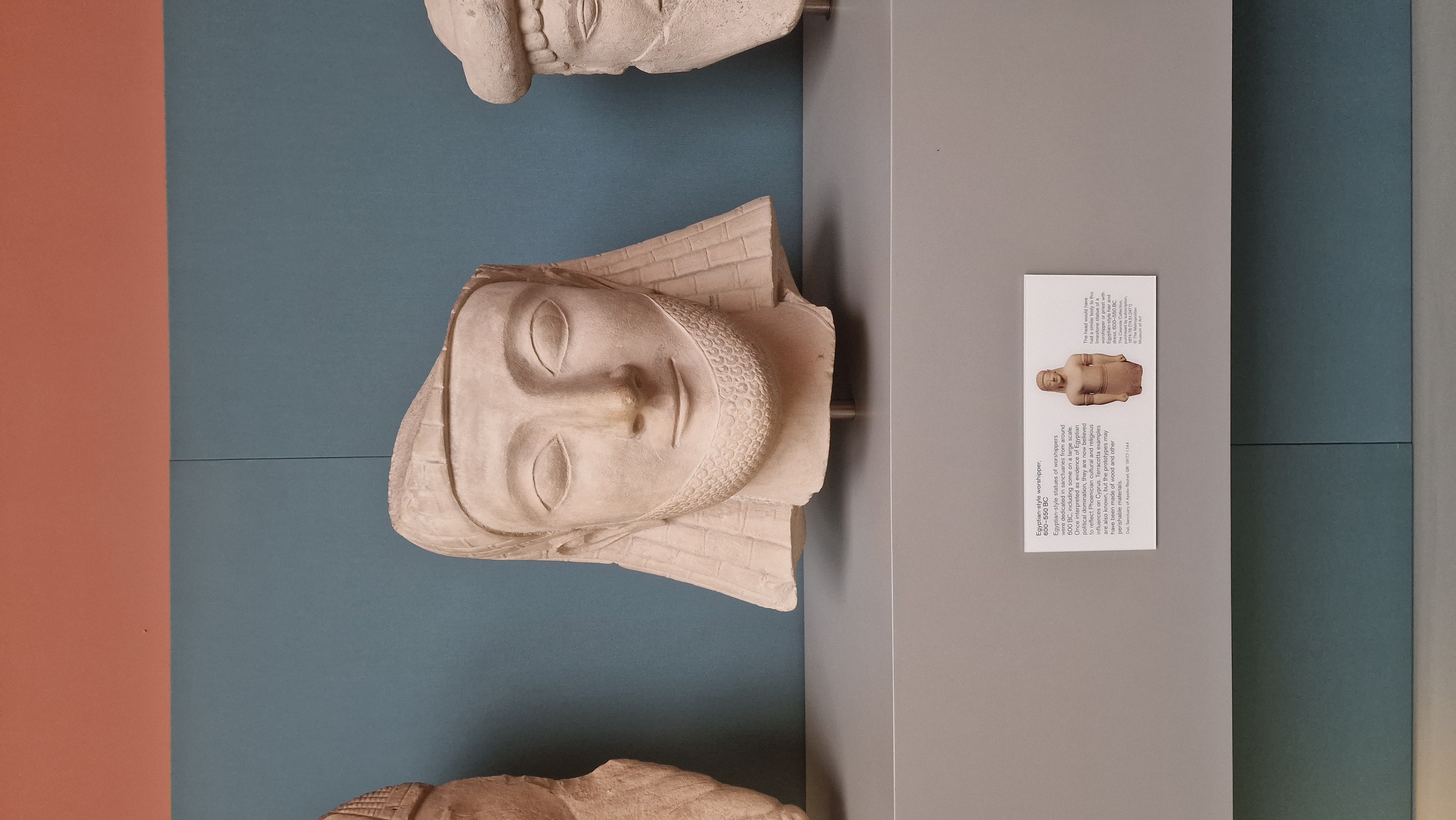
And another bust of good old Caesar (might be interesting as there's so much reference material, and it's so broken):
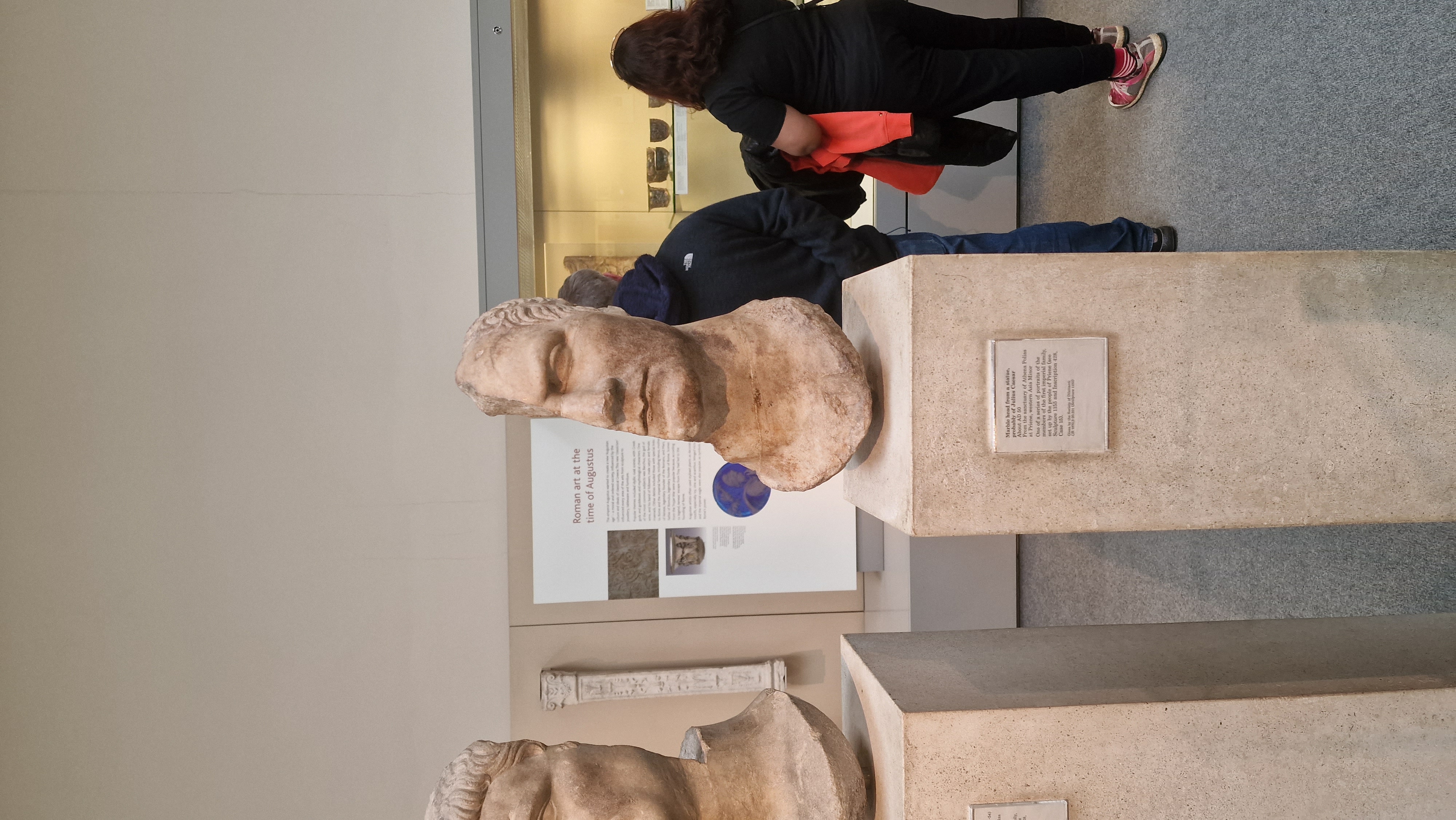
Try it and have fun! I'll try another batch the next time I go.
Cancelling digital minds
Recently, people whose work I admire made me have to confront the "art not artist" dilemma once more. In this case, Nick Bostrom with racism, and Justin Roiland with domestic abuse.
Thinking about it, more generally, I guess it comes down to:
- I can no longer consume a creator's work work without it being tainted by the context of their negative actions, so it became worse for me
- I do not want to a give a voice/reach to their views by making them more famous
- I do not want to do 2 indirectly by financially supporting them
- More selfishly, I do not want to be associated with them or for people to think I support their views/actions by supporting their work
- I do not wanting to signal to others that they can normalise these kinds of views, or behave a certain way, without consequences
However, it makes me think about the question: what if an AI were to be in a similar situation? Done something good and also done something bad. The current vibe seems to be that AI is a "tool" and "guns don't kill people, people kill people". But once you assign agency to AI, it starts opening up unexplored questions I think.
For example, what if you clone an AI state, one goes on to kill, the other goes on to save lives, in what way is the other liable? It's a bit like the entanglement experiment that won the 2022 Nobel physics prize -- you're entangling across space (two forks of a mind) vs time (old "good" version of a celebrity vs new "bad" version of a celebrity) where all versions are equally capable of bad in theory. To what extent are versions of people connected, and their potential?
It also reminds me of the sci-fi story Accelerando by Charles Stross (which I recommend, and you can read online for free here) where different forks of humans can be liable for debts incurred by their forks.
On a related note, I was recently reading a section in Existential Physics by Sabine Hossenfelder titled "Free Will and Morals". Forgive the awful photos, but give it a read:

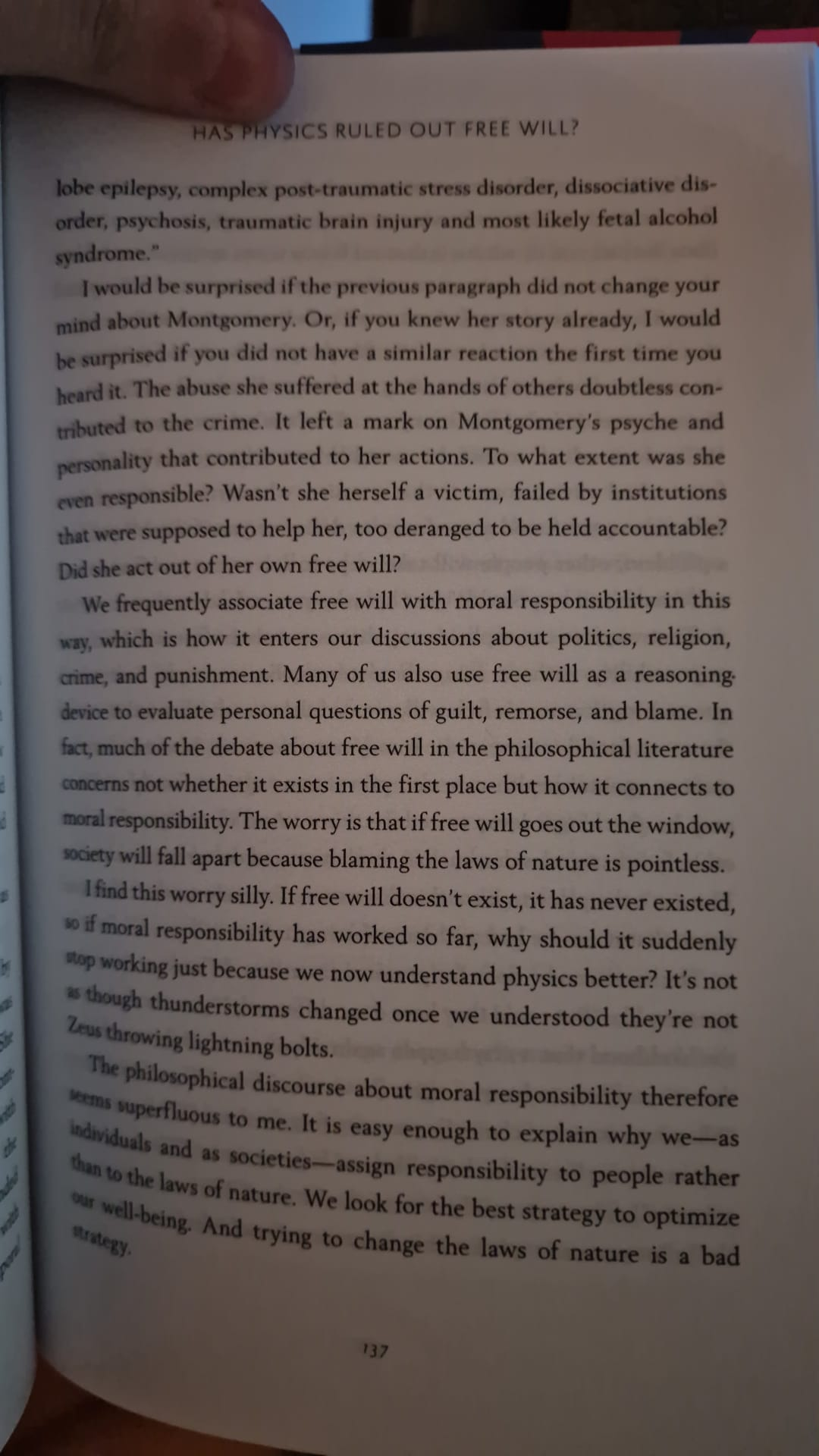
So it doesn't even have to be AI. If someone is criminally insane, they are no longer agents responsible for their own actions, but rather chaotic systems to be managed, just like you don't "blame" the weather for being bad, or a small child for making mistakes.
Then, what if in a sufficiently advanced society we could simply alter our memories or reprogram criminal intent away? Are we killing the undesirable version? The main reasons for punishment are retribution, incapacitation, deterrence, and rehabilitation, but is there research out there that has really thought about how this applies to AI?
There's a fifth reason that applies only to AI: Roko's Basilisk (warning: infohazard) but it's all connected, as I wonder what majority beliefs we hold today that future cultures will find morally reprehensible. It might be things like consuming animals or the treatment of non-human intelligence that is equivalent to or greater than humans by some metric. At least we can say that racism and domestic violence are pretty obviously bad though.
Do NOT use Twilio for SMS
Twilio used to be a cool and trustworthy company. I remember when I was in uni, some CS students (I was not a CS student) built little SMS conversation trees like it was nothing, and suddenly SMS become something you could build things with as a hobby.
Over the past month, my view of Twilio has completely changed.
The attack
Ten days ago (Jan 19th) at around 7am UTC, I woke up to large charges to our business account from Twilio, as well as a series of auto-recharge emails and finally an account suspension email. These charges happened in the span of 3 minutes just before 5am UTC. My reaction at this point was confusion. We were part of Twilio's startup programme and I didn't expect any of our usage to surpass our startup credits at this stage.
I checked the Twilio dashboard and saw that there was a large influx of OTP verification requests from Myanmar numbers that were clearly automated. I could tell that they're automated because they came basically all at once, and mostly from the same IP address (in Palestine). At this point, I realised it was an attack. I could also see that this was some kind of app automation (rather than spamming the underlying API endpoint) as we were also getting app navigation events.
After we were suspended, the verifications failed, so the attack stopped. The attacker seemed to have manually tried a California IP after that some hours later, probably to check if they've been IP blocked, and it probably wasn't a physical phone (Android 7). Then they stopped.
I also saw that our account balance was more than £1.5k in the red (in addition to the charges to our bank account) and our account was suspended until we zero that balance. The timing could not have been worse as we were scheduled to have an important pitch to partners at a tier 1 VC firm. They could be trying the app out already and unable to get in as phone verification was confirmed broken.
Our response
We're on the lowest tier (as a startup) which means our support is limited to email. I immediately opened a ticket to inform Twilio that we were victims of a clear attack, and to ask Twilio for help in blocking these area codes, as we needed our account to be un-suspended ASAP. They took quite a long time to respond, so after some hours I went ahead and paid off the £1.5k balance in order for our account to be un-suspended, with the hope that they can refund us later.
I was scratching my head at what the possible motive of such an attack could be. I thought it must be denial of service, but couldn't think of a motive. We're not big enough for competitors to want to sabotage us, so I was expecting an email at any point from someone asking for bitcoin to stop attacking us, or a dodgy security company coming in and asking for money to prevent it. But Twilio sent an email saying that this is a case of toll fraud.
I recommend reading that article, but in essence, those numbers are premium numbers owned by the attacker, and every time Twilio sends them a verification SMS, they make money, and we foot the bill.
Twilio's response
Twilio seemed to follow a set playbook that they use for these situations. Their documentation names a set of countries as the one where toll fraud numbers most likely come from and recommend are blocked (I suppose it's easy to get premium numbers there): Bangladesh, Sri-Lanka, Myanmar, Pakistan, Uzbekistan, Azerbaijan, Kyrgyzstan, and Nigeria.
I immediately went and blocked those area codes from our side, though Twilio also automatically blocked all countries except the US and the UK anyway, so it didn't really make a difference. Also, the attacker tried again using Indonesian numbers after that, so clearly a blocklist like that is not enough. Later I went and one by one selectively allowed only countries we actually serve.
Beyond this, Twilio's response was to try and do everything to blame this on us. They wash their hands of the responsibility to secure their own APIs, and instead the onus is on us to implement our own unreasonable security measures.
I told a friend about this, and through that friend found out that this is actually a very common problem that people have been having with Twilio, because Twilio dropped the ball. Apparently, out of all of those cases, we got pretty lucky (some people lost 6 figures). For me, the main issues are:
- Why aren't risky countries blocked by default? Worse, why are all countries in the world allowed by default?
- Why isn't "Fraud Guard", one of the switches (free) that Twilio told us we should have turned on, already turned by default?
- I had set up an auto-recharge rule (charge to £20 if balance goes below £10) just in case the startup credits ever ran low. This backfired dramatically as the account kept auto-recharging in an infinite loop until we were suspended (the reason for the huge charges to our bank account). Why?!
- We were already using the default rate-limiting that applies to individual numbers (something like 5 verification requests every 10 minutes), and our server had some general global rate-limiting per-IP (this probably already protected us quite a bit from what could have been). How is it reasonable to expect your clients to put a global rate limit, across IPs and numbers, for specifically the endpoint that asks for Twilio verification? Just have the rate limit on your side maybe? It's not our responsibility to think of these kinds of things; that's why we're using third party provider!
Their email was incredibly patronising, like others have reported, and they acted like they're doing us a huge favour by blessing us with a partial refund in account credits (not even real money). But we need to explain to them first how we promise to be better and not do a silly mistake like this again!
The refund
Twilio tries to push you into agreeing not to dispute the bank charges (see the link above for why they do this). I refused to agree to this, and first wanted to know exactly how much they would refund us, and if they would refund us in real money, not account credits (they agreed to "prioritize" this).
They told us that their finance team is who decides the refund amount, based on the information we provide on how we'll do better and a breakdown of the charges. I told them exactly what we did to combat this, and what the charges were. We had lost a few hundred in startup credits, then just over £2k in real money.
Instead of telling me how much they would refund (remember, I still haven't agreed not to dispute the charges, which they "required" in order to issue a refund), they went ahead and refunded us £847 and some change immediately.
I believe this to be a ploy to try and prevent us from disputing the original charges, because if we dispute now, we would have more back than what they charged.
What now?
I sought some advice, with mixed opinions, but it seems quite clear that if we dispute these charges, at the very least it would mean that we can no longer use Twilio for SMS anymore (which I don't want to anyway). But, this means switching to a different provider before disputing.
It would be relatively easy to switch, as they all tend to work the same way anyway, but would still require:
- Researching other providers (that don't use Twilio in the backend)
- Reading their documentation
- Swapping out the libraries and a dozen or so lines of code
- Making sure we leave no room for another round of toll fraud
- Testing and deploying
This is not difficult, but time and effort that I don't have right now, as well as a distraction from our actual core product. I don't know if £1.1k is worth that "labour", or any extra stress that may come if Twilio decides to make a stink about this and pass us on to collections etc.
All I know is: Twilio, never again. I will advise people to not use Twilio for the rest of my life and longer depending on how that advice may spread and how long this article survives.
New York Pass? Don't do nothin'!
My brother's in New York and I was reminded of a scam we fell for there once. This wasn't the typical Time's Square Elmo-league stuff, but seemed quite legitimate! I wanted to recount the story in case it might help someone.
We were planning to visit the Empire State building (which by the way, wasn't that great, especially that foggy day) and when we arrived there we were shocked to see a queue going all around the block and across several streets. We were approached by a man named DeShawn Cassidy selling the New York Pass.
"You can leave. Your Wallet. At home," he says. "You can laugh at aaaaall these people," as he points to the massive queue, telling us we can skip it with the glorious New York Pass. It's fast-lane entry and cheaper tickets into the Empire State building and a bunch of other attractions around New York within a certain time period.
He was a very convincing and charismatic salesman. We asked him why the people in the queue aren't cleaning him out if it's so good. He threw his hands up and said, "It behooves me!" misunderstanding what that word means.
We paid him $80 for 5 passes I believe, which was a great deal. He rubbed his hands like a fly about to have a meal as we were taking the money out, and gave us a receipt, staking his name and reputation on it, "DeShawn Cassidy", and that we can call him at any time if we need anything.
Of course, you know how the rest of the story goes. DeShawn was all but erased from existence, and we didn't have the opportunity to "laugh at all these people" as the security made us queue like everyone else. The special entrances were only for people who actually worked in the building.
We thought that maybe there's a faster queue inside, after clearing the building queue, and at least we don't need to get new tickets. Wrong again! The man at the till took one look at our little plastic cards, and in the strongest New York accent that still rings in my mind to this day, said the infamous words:
New York Pass? Don't do nothin'!
Digging in to my DNA
A while ago I dug into my DNA via a number of services. I had the uncommon opportunity of being able to compare the results of two services (while only really paying for one). Now I finally got around to writing this up and might update it over time as I do more genealogy-related things. https://yousefamar.com/memo/notes/my/dna/
Marshmallow test puzzle
My friend Selvan sent me this puzzle:
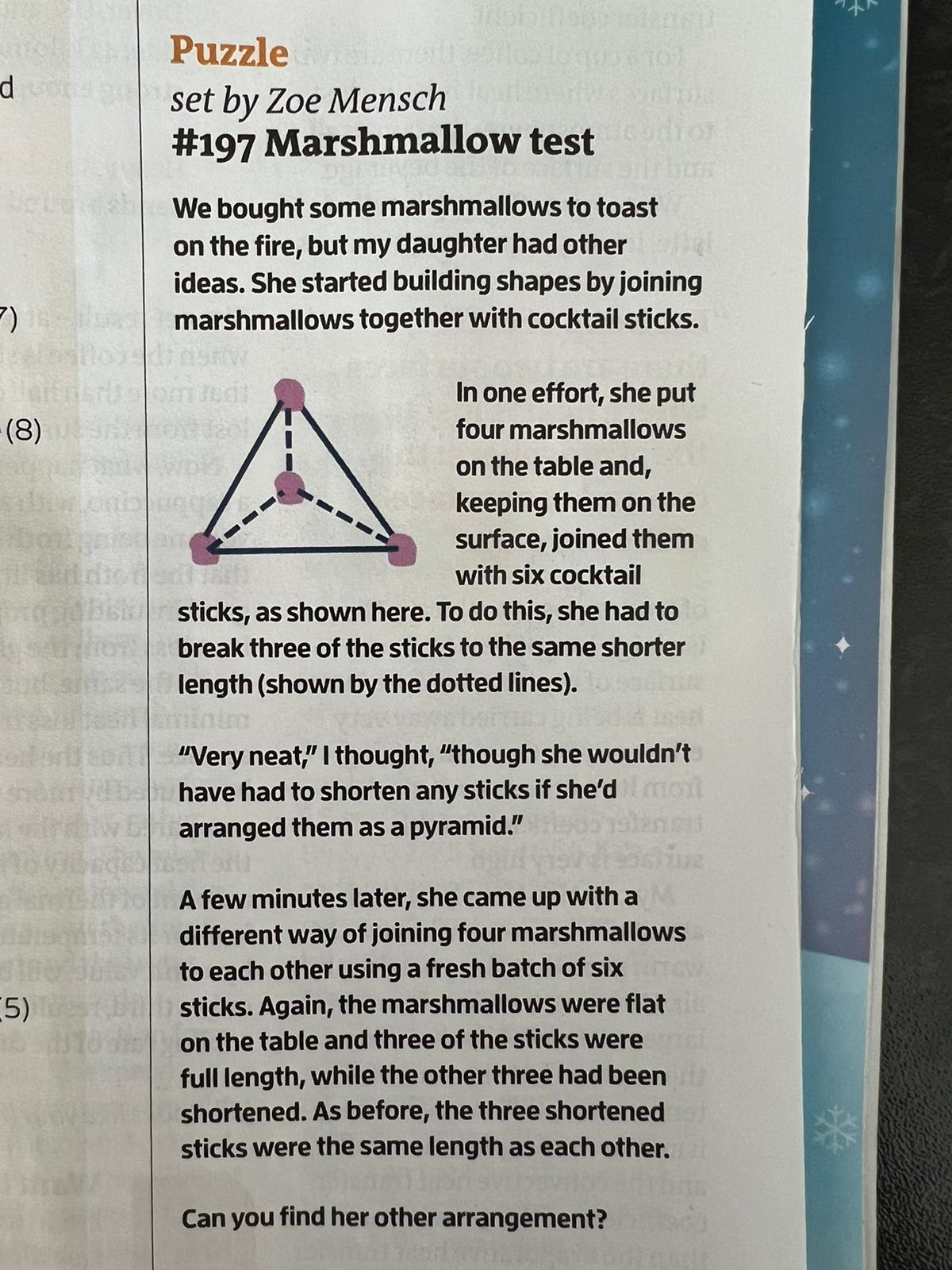
Feel free to give it a try before revealing my thought process and solution! Also, in case you're wondering, the sticks do have to have marshmallows on both ends, and they're straight, and marshmallows can't be in the same position or at infinity. Also, the sticks can cross (this doesn't violate the "2D" requirement). None of this was obvious to me!
My solution
At first, I looked at this as a graph. The graph is undirected and the vertices unlabelled. There are two possible edge weights, and the graph is not allowed to violate the triangle inequality. Intuitively, whenever edge weights are involved, I think of force-directed graphs (like a spring system with different length springs) that relax into a configuration where there's no tension in the springs.
Anyway, if you think about it as a graph, you'll realise that topologically, the first configuration is exactly the same as a square with an X in it. In fact, it's not possible for any other configuration to exist, as a graph with 4 vertices and 6 edges is completely connected. This means that we can't play around with topology, only the edge weights (or rather, move the vertices around, if you think of it that way).
There is no alternative layout where a fourth vertex is inside a triangle like the example, so the vertices *must* be in a quadrilateral layout. If you then build a trapezium using three long sticks and one short stick, you'll quickly see that there's a layout at which the shorter ones are all the same length. I made a visualisation to help illustrate this:
Afterwards, Selvan prompted me to realise that the distance between the bottom left corner and the point of intersection in the middle of the X should be the same as the red line distance, answering at which point exactly the vertices along the red lines are equidistant from each other!
Pringle overload
Almost exactly 6 years ago, I ate too many Pringles, as reminded by my photo app throwback. My brother won a contest where the prize was crates of Pringles and he gave me all the sour cream and onion ones. I ate too many of them in too short a time and since then I kind of lost my taste for them. The same thing happened to me with peanuts — I used to love them and now I basically never eat them.

Oyster vs contactless
When I was a student, I got an oyster photocard for commuting with a discount. Eventually I also had my railcard added to this (though IIRC, the discounts aren't cumulative). I had it renewed right at the last possible moment before expiry and aging out, and the new card was meant to expire on the 31st of Jan 2020. It never did and I've been using it since — maybe expiry meant the discount?
Eventually the outermost plastic layers peeled off (the layer with my name and photo on it) leaving an ominous blank card.
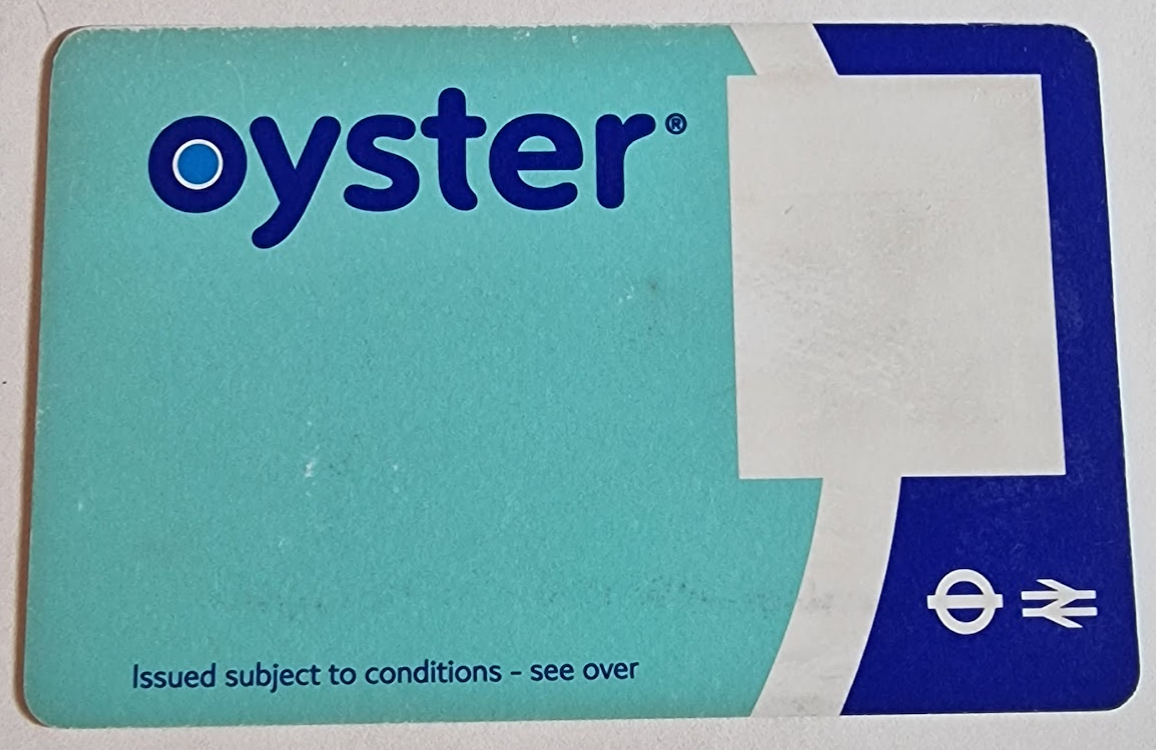
The card number was also peeled off, so when I had an incomplete trip one day, while getting that sorted, a friendly TFL employee let me know what it was on a receipt of my past few journeys. Only then did I really think about what the point of using an oyster card is (since I'm not getting discounts anymore) over a contactless credit card.
It seems there isn't really much of a benefit for me, so I'll probably just let it run out and stop using it. I might draw a little picture in that empty spot.
I had a normal oyster card many many years ago (before the first photocard) that I at some point added to the online dashboard with 60p still on it. I had given this oyster card to a homeless lady thinking there was more than that on it and she probably tossed it. I reckon if I plan my last trip in such a way that the balance goes to -60p, then never top it up again, then my overall balance with TFL should be... well, balanced!